Raghunandhanan Narasimhan writes a detailed tactical analysis about the Premier League match that ended Manchester City 2-1 Arsenal.
Manchester City and Arsenal faced each other at the Etihad as both teams sought to nail a morale boosting win over the other. While City seemed to have shrugged off their thrashing at the hands of Leicester last Saturday by winning 2-0 against Watford midweek, Arsenal lost to Everton at Goodison and looked to put their title challenging hopes back on track.
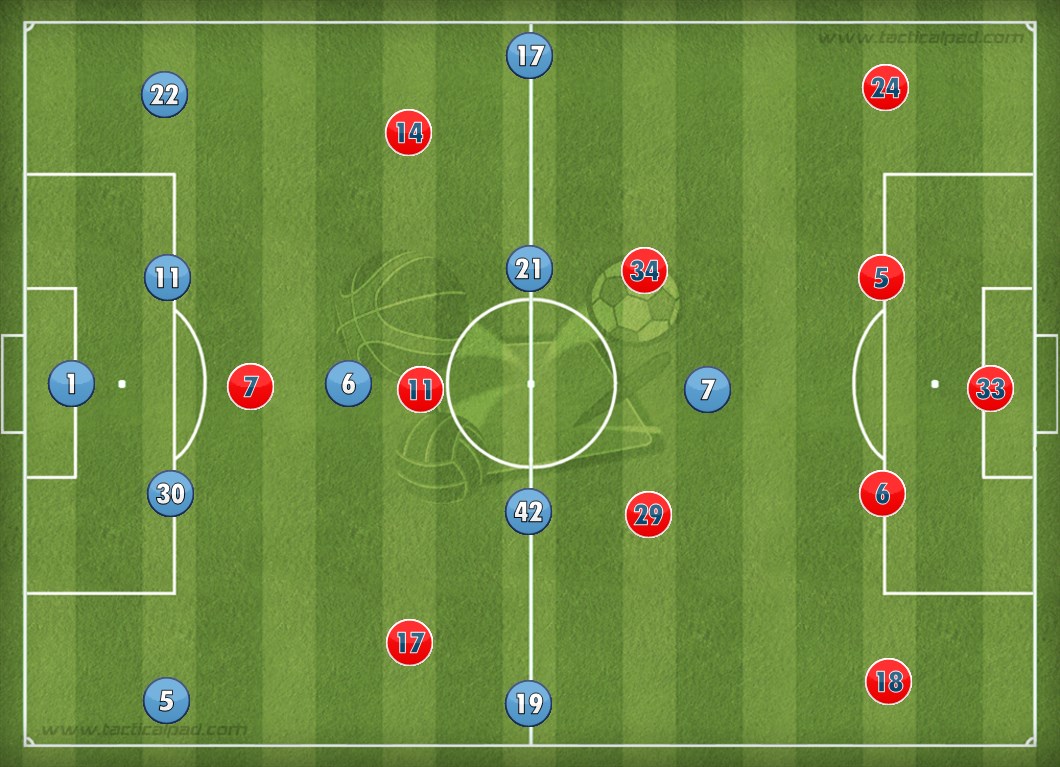
Made using TacticalPad
Man City: Bravo; Zabaleta, Otamendi, Kolarov, Clichy; Fernando, Sané, Touré, Silva, De Bruyne, Sterling.
Arsenal: Cech, Bellerin, Gabriel, Koscielny, Monreal, Coquelin, Xhaka, Walcott, Özil, Iwobi, Sánchez.
City’s disoriented spacing and inability to penetrate
The first half was characterized by City’s inability to enjoy much penetration as Arsenal sat back and looked to hit back on the counter. City are still in their early stages of development under Guardiola as he tries to implement his Juego de Posicion in this City squad. The unfamiliar team set up added with deploying Sterling as the false nine in the first half meant that City were left confused for better parts of the first half. Having been deployed as a winger throughout this season, some of the influence was there to be seen as he looked to beat the final line of defense rather than aid in build up by dropping deep, something that is expected of the role he played in.
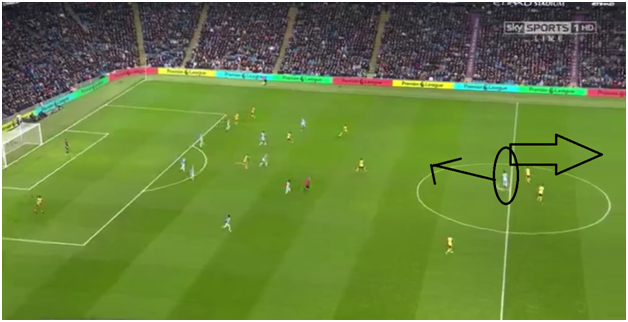
This is one such instance when City had a chance to counter in the first half. When De Bruyne breaks free with the ball Sterling is the only forward passing option he has. In such a situation, especially in a Pep Guardiola system, Sterling has to drop back and help receive the ball and then progress. However he tries to hug the shoulder of the last defender and break free with his pace, something that he tries to do as a winger in this system.
Guardiola seemed to have addressed Fernando’s limitations in passing in comparison to Fernandinho who usually plays as a pivot by having Yaya Toure to drop back and circulate the ball. This however made it easy for Arsenal to block the passing options in midfield due to the close spacing between the two City midfielders.
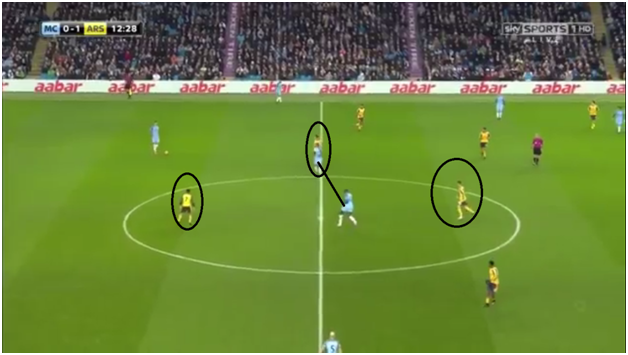
With Sanchez closing the side from which he starts his pressing, Arsenal cover the two immediate midfielders. Build up play is the cornerstone on which Guardiola bases his team’s play on. By preventing this, Arsenal could control the direction of play even though they did not enjoy much possession.
Another feature of City’s build up play was that if the ball was being progressed along a flank, the respective full back would bomb up forward to give the added passing option. Zabaleta especially spent the better part of the first half in the opposition half as he patrolled the half spaces. Shades of Juego de posicion were again visible as the ball near winger(Sane) would move to the wing while Zabaleta would be found in the half space. Rather than the overlapping runs, the inverted full back was there to be seen as City tried to navigate their way through Arsenal. The major reason why City found it difficult to break the Arsenal resistance was because they played into Arsenal’s hands by mirroring the Arsenal’s defensive set up. When the center backs split up, Clichy and Zabaleta moved up on the flanks. As previously mentioned, Yaya Toure dropped back along with Fernandinho and helped bring out the ball. With De Bruyne and Sane staying wide, there were certain instances where Silva and Sterling along with the wide men were found forward in a front four. With no forward passing options in such cases, City kept playing sideways with not much effect.
Arsenal’s deep bock and man orientation
Arsenal, being more used to pressing high up with Sanchez playing a key part in it, adopted a more cautious approach by inviting City onto them. Their man oriented covering of zones however did not change. There were instances where City could exploit them by quick exchanges. When occupying the final third, the full backs from City pushed up to the flanks while KDB and Sane were in the half spaces.
Arsenal defended in a 4-4-2 that often varied according to Ozil’s involvement in the defensive phases. In such cases, the formation varied between 4-4-1-1 or a 4-5-1. Sanchez was directed to press the ball carriers in the first line of City build up and hurried them into quick passes. By covering the immediate passing options in Fernando and Toure in the center, Arsenal could easily force the City defenders to play long balls. The problem of playing a double pivot in such situations was exploited by Arsenal as they could easily cover them both. As the half progressed, Ozil did not position himself aggressively so as to prevent the City players to build up easily. Rather, he dropped in behind Sanchez or into the midfield line and covered Toure or Fernando. By adopting such an approach, Arsenal were able to deny City their build up routes and switches of play which are instrumental in the way they play.
Yaya Toure often dropped deeper and brought the ball out. Another way City looked to circulate the ball was by the spacing of Toure and Fernando in the subsequent lines of defense and not essentially in a single double pivotal line.
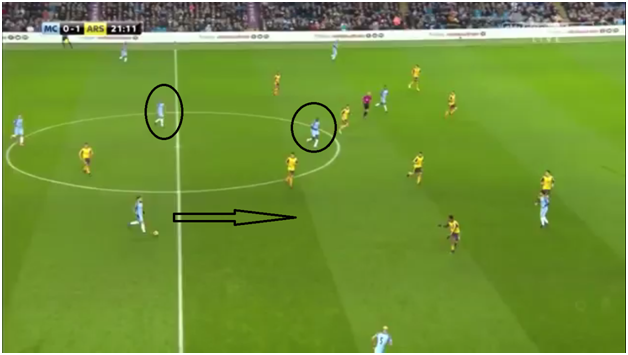
By moving onto the next line of buildup, Toure could now open up space for Fernando to receive the ball freely. This spacing also meant that the center backs who were in possession of the ball could bring it out freely as there were large spaces in front of them due to the movement of Fernando and Toure.
Another feature that was evident as the half progressed was the decreased pressure on the City defenders and the deep block from Arsenal. From playing a midblock in the initial stages of the half, Arsenal retreated into a very compact shape and all the players were found camped inside Arsenal’s half as they looked to suffocate space.
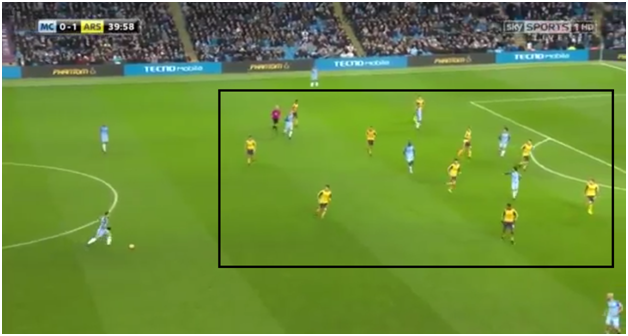
The deep block is evident here with all the ten Arsenal outfield players staying compact. The ball carrier is not pressurized and rather focus is on maintaining the shape and cramping out space.
City’s improved and aggressive counterpressing in the second half
The major change in City’s play in second half was that they started playing more aggressively while their pressing once they lost the ball was much improved. The simple but effective change of shifting De Bruyne to the center to play the false nine role while Sterling moved to the right and Sane to the left, paid dividends as City started to enjoy better moments. The dominance enjoyed by City in the second half was helped in a major way by Arsenal’s extreme passivity as there were numerous instances when their midfield was found lacking dynamism and just walking around. The quick exchanges facilitated by the ever growing Yaya Toure meant that Arsenal needed to cover spaces even better due to the approach they had taken. Arsenal are not usually a team that sit back for long periods in time in a disciplined fashion. They rather control possession and move around the opposition with their passing. So it was a bit expected that they would tire eventually and lose discipline. However City took the initiative and started playing with much more aggression and pinned Arsenal back in their half. The switch of De Bruyne to the center was also instrumental as his ball distribution and decision making in such a demanding role far exceeds that of Sterling.
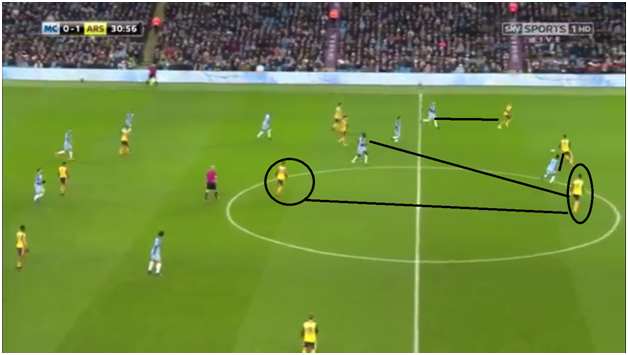
This was an instance from the first half where the City players showed sub optimal reactions to quick exchanges from the Arsenal players. Trying to press Arsenal from the top, the City players lacked the cohesion to force an effective turnover. With Gabriel in possession of the ball, Sterling looks to close him down. A quick pass to Xhaka who positions himself between Silva and Toure, the City plyers are again slow to react, meaning that Arsenal can easily bypass this disoriented press when Xhaka passes the ball to Koscielny(circled) and bring the ball out. This also meant that Arsenal had a lot of space in between the lines to exploit and attack City.
Relatively, in the second half City players took better aggressive positions and also had an organized air about it.
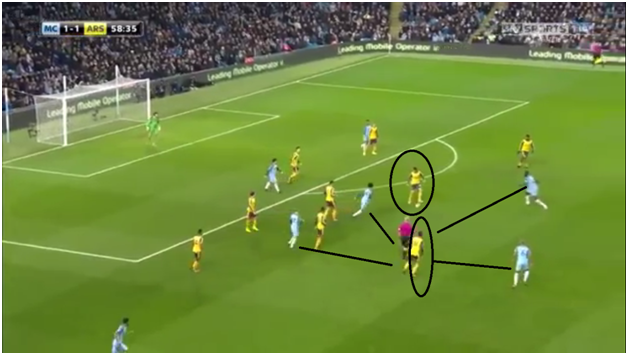
All the City players were better positioned to counter press the ball high up the pitch and win possession back from Arsenal. The striking feature of their pressing was that the forwards came back and pressed along with the midfielders. Added to this, the very closely spaced Arsenal players could not effectively pass their way out of trouble.
The major factor that contributed to City’s dominance was the lack of running in the midfield to cover spaces by Arsenal. Barring Alexis Sanchez, none of the Arsenal players closed down City players and therefore as a result, City could circulate the ball with relative ease. With the dynamism in City’s front line boosted by De Bruyne’s shift in position, Arsenal did not replicate the same energy to make sure they stayed compact. With gaps starting to appear in the attacking third, City constantly payed their way through Arsenal. This, added to their counterpressing, meant that City monopolized the ball and were able to make the decisive breakthrough.
A lot of situations where there were overloads in concentrated areas were seen from City. Fatigue was starting to set in as Arsenal did not seem to be able to cope with the metronome like passing from City. Another flaw that surfaced from an Arsenal perspective was the disoriented pressing from them. There were instances wherein Sanchez would go on to press a ball carrier only to see that his team mates had not followed suit.
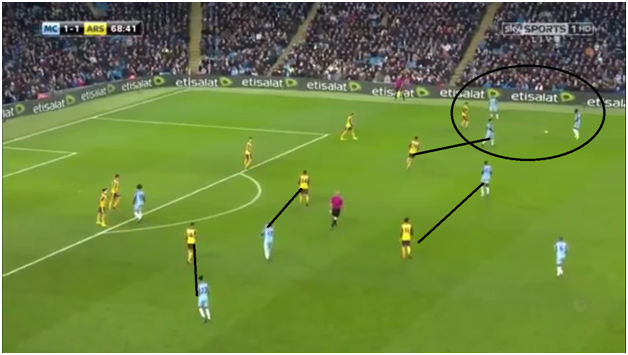
The distance between City and Arsenal players can be seen here as no one got close enough to a City player to close them down. City kept creating simple overloads( circled) and carved open Arsenal. Their transitions once they won the ball back higher up the pitch was top notch and all this contributed to their superiority in the second half.
Conclusion
Pep Guardiola would have been delighted with his team’s second half performance as his side dominated Arsenal in all phases of the game. Arsenal’s lack of coordination in defensive phases yet again came to light as they lost their second consecutive league game in a week. Arsenal have a lot of work to do if they are to mount a serious title challenge this year while City can hope to kickstart their own title challenging hopes after a series of indifferent results.
Read all our Tactical Analyses here.
Manchester United fan and a tactics afficianado. Loves quality holding midifielders


























































